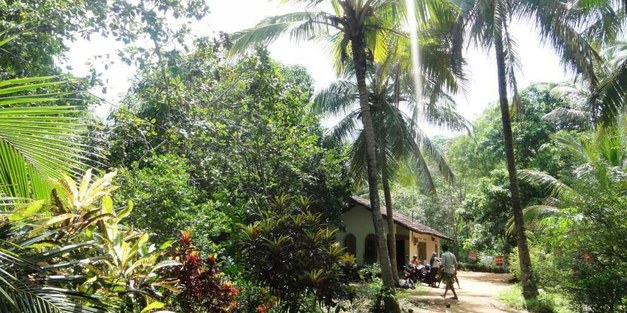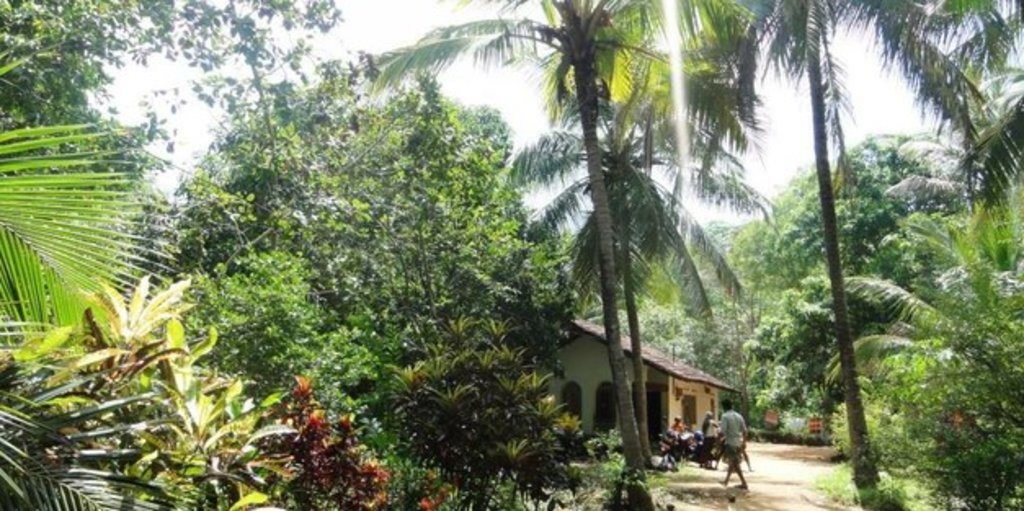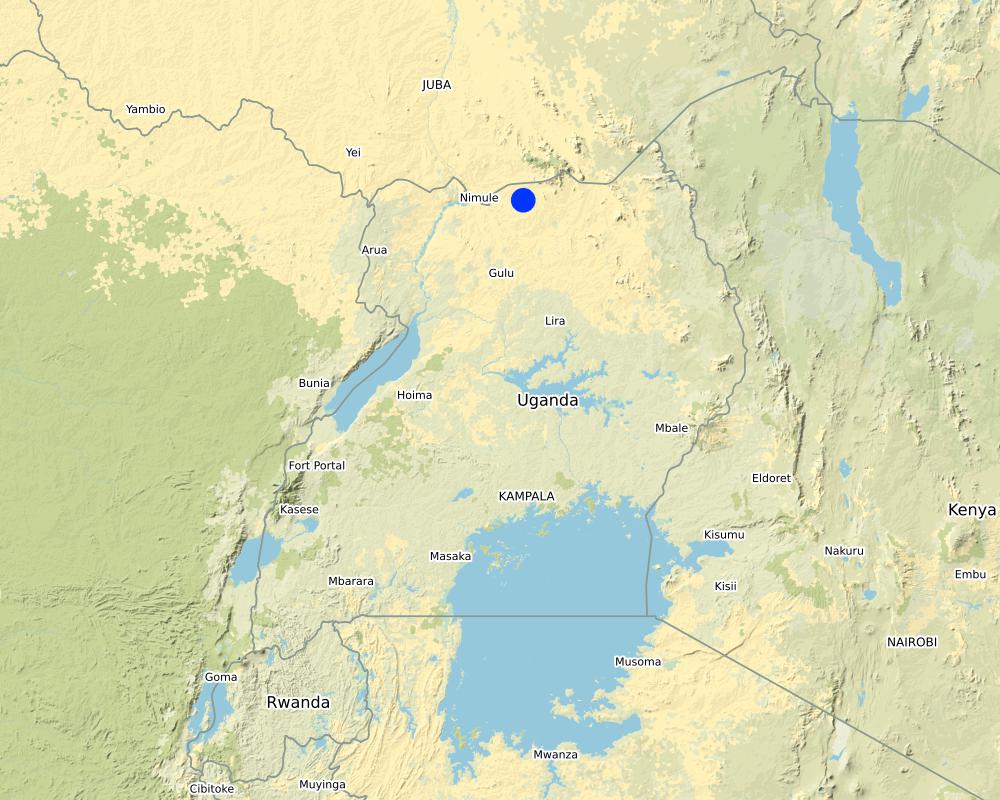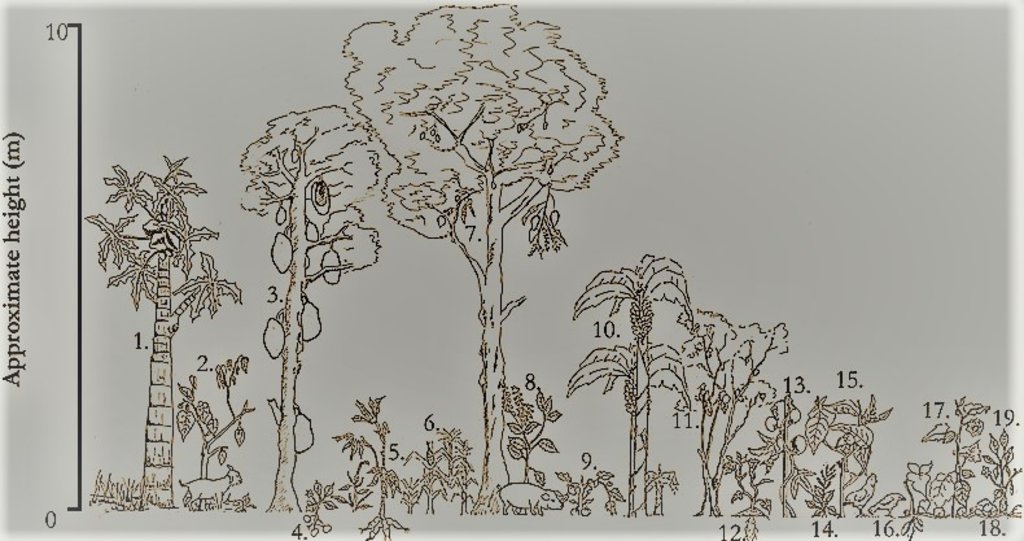Home Gardens [អ៊ូហ្គង់ដា]
- ការបង្កើត៖
- បច្ចុប្បន្នភាព
- អ្នកចងក្រង៖ Bernard Fungo
- អ្នកកែសម្រួល៖ JOY TUKAHIRWA, Kamugisha Rick Nelson, betty adoch, Sunday Balla Amale
- អ្នកត្រួតពិនិត្យច្រើនទៀត៖ Nicole Harari, Stephanie Jaquet, Udo Höggel
Yen apita gang ki nyig yat
technologies_2881 - អ៊ូហ្គង់ដា
ពិនិត្យមើលគ្រប់ផ្នែក
ពង្រីកមើលទាំងអស់ បង្រួមទាំងអស់1. ព័ត៌មានទូទៅ
1.2 ព័ត៌មានលម្អិតពីបុគ្គលសំខាន់ៗ និងស្ថាប័នដែលចូលរួមក្នុងការវាយតម្លៃ និងចងក្រងឯកសារនៃបច្ចេកទេស
ឈ្មោះគម្រោងដែលបានចងក្រងឯកសារ/ វាយតម្លៃលើបច្ចេកទេស (បើទាក់ទង)
Scaling-up SLM practices by smallholder farmers (IFAD)ឈ្មោះអង្គភាពមួយ (ច្រើន) ដែលបានចងក្រងឯកសារ/ វាយតម្លៃបច្ចេកទេស (បើទាក់ទង)
Uganda Landcare Network (ULN) - អ៊ូហ្គង់ដា1.3 លក្ខខណ្ឌទាក់ទងទៅនឹងការប្រើប្រាស់ទិន្នន័យដែលបានចងក្រងតាមរយៈ វ៉ូខេត
តើពេលណាដែលទិន្នន័យបានចងក្រង (នៅទីវាល)?
13/4/2017
អ្នកចងក្រង និង(បុគ្គលសំខាន់ៗ)យល់ព្រមទទួលយកនូវលក្ខខណ្ឌនានាទាក់ទងទៅនឹងការប្រើប្រាស់ទិន្នន័យដែលបានចងក្រងតាមរយៈវ៉ូខេត:
បាទ/ចា៎
1.4 សេចក្តីប្រកាសស្តីពីចីរភាពនៃការពណ៌នាពីបច្ចេកទេស
តើបច្ចេកទេសដែលបានពណ៌នានេះមានបញ្ហាដែលផ្តោតលើការធ្លាក់ចុះគុណភាពដី, បើដូច្នេះវាមិនអាចត្រូវបានប្រកាសថាជាបច្ចេកទេសនៃការគ្រប់គ្រងប្រកបដោយចីរភាពទេ?
ទេ
2. ការពណ៌នាពីបច្ចេកទេស SLM
2.1 ការពណ៌នាដោយសង្ខេបពីបច្ចេកទេស
និយមន័យបច្ចេកទេស:
Home gardens provide low-income households with continuous food supply and increase the resilience of their livelihoods to climate change
2.2 ការពណ៌នាលម្អិតពីបច្ចេកទេស
ការពណ៌នា:
Home gardens are area where the cultivation of a small portion of land, usually around a homestead or within walking distance from the family home. Usually, a mixture of several crops that may include vegetables, fruits, plantation crops, spices, herbs, ornamental and medicinal plants as well as livestock that can serve as a supplementary source of food and income. Home gardens are a cropping system composed of soil, crops, weeds, pathogens and insects that convert resource inputs - solar energy, water, nutrients, labor, etc. - into food, feed, fuel, fiber and pharmaceuticals. Home gardens are important ways to ensure that the low-income households have access to the all the basic livelihood needs throughout the year. This is a resilience technology for resource-constrained farmers in remote parts of the world. During the wet season, farmers plant additional crops mainly vegetables to utilize the lower-storey niches because such crops are more shade tolerant. The multi-species and multi-canopy structure of the farming systems ensures stability against climate extremes such as drought, strong winds and dry spells.
The main features that characterize a home garden are (1) located near the residence; (2) containing a high diversity of plants; (3) production is supplemental rather than a main source of family consumption and income; (4) occupying a small area (~3 acres) and (5) requiring very low external inputs, relying mainly on recycling of crop residues and cow dung and seed from previous season’s harvest.
Home gardens play the role of producing subsistence items and generating additional income for the household. They are known for their stable yields, very varied products, continuous or repeated harvests during the year and low inputs. Whereas home gardens may not be the major sources of livelihood, they are known to contribute 10-35 percent of livelihoods of farmers and their productivity is reported to be up to 20 times that of other land uses such as irrigated fields, rise fields and fish ponds. home gardens are also an important source of nutrients providing approximately 10, 12, 150, 16, 31, 25 and 113 percent of the minimum daily requirement of protein, calcium, carotene, thiamine, riboflavin, niacin and ascorbic acid, respectively.
A large proportion of the products of home gardens is consumed by farmer families especially due to the remoteness of the area where a market economy has not yet developed. Home gardens also play sociol-cultural functions and provide products for religious rituals and ceremonies. The aesthetic role of home gardens is also considered important especially during the dry season when people spend evenings out in the garden. Hence, paying attention solely to the tangible economic and nutritional gains of home gardens, and agroforestry in general misses the various intangible ecological and social values.
2.3 រូបភាពនៃបច្ចេកទេស
2.4 វីដេអូនៃបច្ចេកទេស
កាលបរិច្ឆេទ:
13/2017
ទីតាំង:
Lamwo District , Northern Uganda
ឈ្មោះអ្នកថតវីឌីអូ:
Issa Aliga
2.5 ប្រទេស/តំបន់/ទីតាំងកន្លែង ដែលបច្ចេកទេសត្រូវបានអនុវត្ត និងបានគ្រប់ដណ្តប់ដោយការវាយតម្លៃនេះ
ប្រទេស:
អ៊ូហ្គង់ដា
តំបន់/រដ្ឋ/ខេត្ត:
Lamwo District, Northern Uganda
មតិយោបល់:
Coordinates of only one location are indicated but there were several sites with home gardens.
Map
×2.6 កាលបរិច្ឆេទនៃការអនុវត្ត
បង្ហាញឆ្នាំនៃការចុះអនុវត្ត:
2008
2.7 ការណែនាំពីបច្ចេកទេស
សូមបញ្ជាក់តើបច្ចេកទេសត្រូវបានណែនាំឱ្យអនុវត្តដោយរបៀបណា:
- ជាផ្នែកនៃប្រព័ន្ធប្រពៃណី (> 50 ឆ្នាំ)
3. ចំណាត់ថ្នាក់នៃបច្ចេកទេស SLM
3.1 គោលបំណងចម្បង (១ ឬច្រើន) នៃបច្ចេកទេសនេះ
- ធ្វើឱ្យប្រសើរឡើងនូវផលិតកម្ម
- អភិរក្សប្រព័ន្ធអេកូឡូស៊ី
- កាត់បន្ថយហានិភ័យនៃគ្រោះមហន្តរាយ
- បន្ស៊ាំទៅនឹងការប្រែប្រួលអាកាសធាតុ/គ្រោះមហន្តរាយ និងផលប៉ះពាល់របស់វា
- បង្កើតផលប្រយោជន៍សេដ្ឋកិច្ច
- បង្កើតផលប្រយោជន៍សង្គម
3.2 ប្រភេទដីប្រើប្រាស់មួយប្រភេទ (ច្រើនប្រភេទ) ដែលបានអនុវត្តបច្ចេកទេស

ចម្រុះ (ដំណាំ/ វាលស្មៅ/ ដើមឈើ)គិតទាំងកសិរុក្ខកម្ម
- កសិរុក្ខកម្ម
- ដីដាំដំណាំ និងចិញ្ចឹមសត្វ
- ដាំដំណាំ ចិញ្ចឹមសត្វ និងឈើ
- ដីព្រៃឈើ និងដីចិញ្ចឹមសត្វ
មតិយោបល់:
All elements of agroforoestry are present in the home gardens
3.3 ព័ត៌មានបន្ថែមអំពីអ្នកប្រើប្រាស់ដី
ការផ្គត់ផ្គង់ទឹកនៅកន្លែងអនុវត្តបច្ចេកទេស:
- ទឹកភ្លៀង
ចំនួនសារដែលដាំដំណាំក្នុងមួយឆ្នាំ:
- 2
សូមបញ្ជាក់:
March to May and September to November
3.4 ក្រុម SLM ដែលបច្ចេកទេសស្ថិតនៅក្នុង
- កសិរុក្ខកម្ម
- គេហសួន
3.5 ការសាយភាយនៃបច្ចេកទេស
បញ្ជាក់ពីការសាយភាយនៃបច្ចេកទេស:
- ត្រូវបានផ្សព្វផ្សាយត្រឹមតំបន់មួយ
ប្រសិនបើបច្ចេកទេសត្រូវបានសាយភាយពាសពេញតំបន់ណាមួយ សូមកំណត់ទំហំផ្ទៃដីអនុវត្តន៍:
- < 0.1 គម2 (10 ហិកតា)
មតិយោបល់:
Home gardens are usually smaller than 3 acres
3.6 វិធានការ SLM ដែលបញ្ចូលនូវបច្ចេកទេស

វិធានការក្សេត្រសាស្ត្រ
- A1: ដំណាំ/គម្របដី

វិធានការរុក្ខជាតិ
- V1: ឈើធំៗ និងដើមឈើតូចៗ

វិធានការរចនាស័ម្ពន្ធ
- S9: រោងដំណាំ និងរោងចិញ្ចឹមសត្វ

វិធានការគ្រប់គ្រង
- M5: គ្រប់គ្រង/ ការប្លាស់ប្តូរសមាសភាពពូជ
3.7 កំណត់ប្រភេទនៃការធ្លាក់ចុះគុណភាពដីសំខាន់ៗដែលបច្ចេកទេសនេះបានដោះស្រាយ

ការធ្លាក់ចុះជីវសាស្ត្រនៃដី
- Bc: ការថយចុះនូវគម្របរុក្ខជាតិ
- Bh: ការបាត់បង់ទីជំរក
3.8 ការពារ កាត់បន្ថយ ឬស្តារឡើងវិញនៃការធ្លាក់ចុះគុណភាពដី
បញ្ជាក់ពីគោលដៅរបស់បច្ចេកទេស ដែលផ្តោតទៅការធ្លាក់ចុះគុណភាពដី:
- ការការពារការធ្លាក់ចុះគុណភាពដី
- ការបន្ស៊ាំទៅនឹងការធ្លាក់ចុះគុណភាពដី
4. បច្ចេកទេសជាក់លាក់ សកម្មភាពអនុវត្ត ធាតុចូល និងថ្លៃដើម
4.1 គំនូសបច្ចេកទេសនៃបច្ចេកទេសនេះ
ឈ្មោះអ្នកនិពន្ធ:
Adapted from (Whitney et al. 2017) Artwork by Carolyne Nakaketo.
កាលបរិច្ឆេទ:
13/4/2017
4.2 លក្ខណៈពិសេសនៃបច្ចេកទេស/ ពណ៌នាពីគំនូរបច្ចេកទេស
A typical multilayered Ugandan homegarden structure showing approximate heights for a diversity of edible species. Plants numbered: 1. Carica papaya, 2. Solanum betaceum, 3. Artocarpus heterophyllus, 4. Solanum tuberosum, 5. Manihot esculenta, 6. Zea mays, 7. Mangifera indica, 8. Ocimum gratissimum, 9. Solanum lycopersicum, 10. Musa spp., 11. Psidium guajava, 12. Ipomoea batatas, 13. Passiflora spp., 14. Amarathus spp., 15. Solanum aethiopicum, 16. Xanthasoma spp., 17. Physalis peruviana, 18. Cucurbita spp., and 19. Capsicum spp.
- Land area is approximately 3 acres
-The mixture of plant species benefits form the various niches within the canopy
-Taller, light demanders occupy the upper canopy while the shorter shade tolerant ones occupy the lower canopy
- The homestead is within few meters (< 50 m) of the crop and livestock setting
- Livestock shelter usually located under trees to protect them from hot sunshine
- Kitchen residues are spread in the nearby are, providing fertility to the crops therein. Therefore, the plants nearer the house are generally more healthy
- The home garden is more or less a closed system with limited external input or export of resources to outside
4.3 ព័ត៌មានទូទៅដែលពាក់ព័ន្ធនឹងការគណនាធាតុចូល និងថ្លៃដើម
កំណត់របៀបនៃការគណនាថ្លៃដើម និងធាតុចូល:
- ក្នុងឯកតាបច្ចេកទេស
បញ្ជាក់ឯកតា:
Acres
បញ្ជាក់ទំហំ ប្រវែង ។ល។ (បើពាក់ព័ន្ធ):
3
ផ្សេងៗ/ រូបិយប័ណ្ណជាតិ (បញ្ជាក់):
Uganda Shillings
កំណត់អត្រាប្តូរប្រាក់ពីដុល្លាទៅរូបិយប័ណ្ណតំបន់ (បើទាក់ទង)៖ 1 ដុល្លារ =:
3500,0
កំណត់ថ្លៃឈ្នួលជាមធ្យមនៃការជួលកម្លាំងពលកម្មក្នុងមួយថ្ងៃ:
5000
4.4 សកម្មភាពបង្កើត
| សកម្មភាព | ប្រភេទវិធានការ | ពេលវេលា | |
|---|---|---|---|
| 1. | Planting | ក្សេត្រសាស្ត្រ | Start of wet season |
| 2. | Weeding | ការគ្រប់គ្រង | Throughout the year |
| 3. | Manure management | ការគ្រប់គ្រង | Throughout the year |
| 4. | Pruning | ក្សេត្រសាស្ត្រ | Throughout the year |
4.5 ថ្លៃដើម និងធាតុចូលដែលត្រូវការសម្រាប់ការបង្កើតបច្ចេកទេស
| បញ្ជាក់ពីធាតុចូល | ឯកតា | បរិមាណ | ថ្លៃដើមក្នុងមួយឯកតា | ថ្លៃធាតុចូលសរុប | % នៃថ្លៃដើមដែលចំណាយដោយអ្នកប្រើប្រាស់ដី | |
|---|---|---|---|---|---|---|
| កម្លាំងពលកម្ម | Planting | Days | 20,0 | 5000,0 | 100000,0 | 100,0 |
| កម្លាំងពលកម្ម | Weeding | Days | 20,0 | 5000,0 | 100000,0 | 100,0 |
| កម្លាំងពលកម្ម | Manure Management | Days | 20,0 | 5000,0 | 100000,0 | 100,0 |
| កម្លាំងពលកម្ម | Pruning | Days | 20,0 | 5000,0 | 100000,0 | 100,0 |
| សម្ភារៈដាំដុះ | Seeds | kg | 5,0 | 50000,0 | 250000,0 | 100,0 |
| សម្ភារៈដាំដុះ | Suckers and stem cuttings | pieces | 200,0 | 500,0 | 100000,0 | 100,0 |
| ជី និងសារធាតុពុល | Animal manure | kg | 2000,0 | 2000,0 | 4000000,0 | 100,0 |
| សម្ភារៈសាងសង់ | Poles | Pieces | 100,0 | 5000,0 | 500000,0 | 100,0 |
| សម្ភារៈសាងសង់ | Nails | kg | 15,0 | 3000,0 | 45000,0 | 100,0 |
| ថ្លៃដើមសរុបក្នុងការបង្កើតបច្ចេកទេស | 5295000,0 | |||||
4.6 សកម្មភាពថែទាំ
| សកម្មភាព | ប្រភេទវិធានការ | ពេលវេលា/ ភាពញឹកញាប់ | |
|---|---|---|---|
| 1. | Planting | ក្សេត្រសាស្ត្រ | Once a year |
| 2. | Weedindg | ការគ្រប់គ្រង | Twice a year |
| 3. | Prunning | ការគ្រប់គ្រង | Three times a year |
| 4. | Manure manageemnt | ការគ្រប់គ្រង | Throughout the year |
4.7 កំណត់ថ្លៃដើមសម្រាប់ការថែទាំ/ សកម្មភាពរបស់បច្ចេកទេស (ក្នុងរយៈពេលមួយឆ្នាំ)
បើអាច បំបែកថ្លៃដើមនៃការថែទាំទៅតាមតារាងខាងក្រោម បញ្ជាក់ធាតុចូលលម្អិត និងថ្លៃដើមក្នុងមួយឯកតា។ បើអ្នកមិនអាចបំបែកបាន សូមផ្តល់នូវតម្លៃប៉ាន់ស្មាននៃការថែទាំបច្ចេកទេសសរុប:
300000,0
| បញ្ជាក់ពីធាតុចូល | ឯកតា | បរិមាណ | ថ្លៃដើមក្នុងមួយឯកតា | ថ្លៃធាតុចូលសរុប | % នៃថ្លៃដើមដែលចំណាយដោយអ្នកប្រើប្រាស់ដី | |
|---|---|---|---|---|---|---|
| កម្លាំងពលកម្ម | Planting | Days | 20,0 | 5000,0 | 100000,0 | 100,0 |
| កម្លាំងពលកម្ម | Weeding | Days | 20,0 | 5000,0 | 100000,0 | 100,0 |
| កម្លាំងពលកម្ម | Manure management | Days | 20,0 | 5000,0 | 100000,0 | 100,0 |
| កម្លាំងពលកម្ម | Pruning | Days | 20,0 | 5000,0 | 100000,0 | 100,0 |
| សម្ភារៈ | 3,0 | |||||
| សម្ភារៈដាំដុះ | Seeds | kg | 2,0 | 30000,0 | 60000,0 | 100,0 |
| សម្ភារៈដាំដុះ | Suckers and stem cuttings | Pieces | 50,0 | 500,0 | 25000,0 | 100,0 |
| ជី និងសារធាតុពុល | Manure | kg | 2000,0 | 2000,0 | 4000000,0 | 100,0 |
| សម្ភារៈសាងសង់ | Poles | Pieces | 30,0 | 5000,0 | 150000,0 | 100,0 |
| សម្ភារៈសាងសង់ | Nails | kg | 5,0 | 5000,0 | 25000,0 | 100,0 |
| ថ្លៃដើមសរុបសម្រាប់ការថែទាំដំណាំតាមបច្ចេកទេស | 4660000,0 | |||||
4.8 កត្តាសំខាន់បំផុតដែលមានឥទ្ធិពលដល់ការចំណាយ
ពណ៌នាពីកត្តាប៉ះពាល់ចម្បងៗទៅលើថ្លៃដើម:
Labour for maintaining the garden, especially pruning
5. លក្ខណៈបរិស្ថានធម្មជាតិ និងមនុស្ស
5.1 អាកាសធាតុ
បរិមាណទឹកភ្លៀងប្រចាំឆ្នាំ
- < 250 មម
- 251-500 មម
- 501-750 មម
- 751-1,000 មម
- 1,001-1,500 មម
- 1,501-2,000 មម
- 2,001-3,000 មម
- 3,001-4,000 មម
- > 4,000 មម
តំបន់កសិអាកាសធាតុ
- មានភ្លៀងមធ្យម
5.2 សណ្ឋានដី
ជម្រាលជាមធ្យម:
- រាបស្មើ (0-2%)
- ជម្រាលតិចតួច (3-5%)
- មធ្យម (6-10%)
- ជម្រាលខ្ពស់បន្តិច (11-15%)
- ទីទួល (16-30%)
- ទីទួលចោត (31-60%)
- ទីទួលចោតខ្លាំង (>60%)
ទម្រង់ដី:
- ខ្ពង់រាប
- កំពូលភ្នំ
- ជម្រាលភ្នំ
- ជម្រាលទួល
- ជម្រាលជើងភ្នំ
- បាតជ្រលងភ្នំ
តំបន់តាមរយៈកម្ពស់ :
- 0-100 ម
- 101-500 ម
- 501-1,000 ម
- 1,001-1,500 ម
- 1,501-2,000 ម
- 2,001-2,500 ម
- 2,501-3,000 ម
- 3,001-4,000 ម
- > 4,000 ម
បញ្ជាក់ថាតើបច្ចេកទេសនេះត្រូវបានអនុវត្តន៍នៅក្នុង:
- មិនពាក់ព័ន្ធទាំងអស់
5.3 ដី
ជម្រៅដីជាមធ្យម:
- រាក់ខ្លាំង (0-20 សម)
- រាក់ (21-50 សម)
- មធ្យម (51-80 សម)
- ជ្រៅ (81-120 សម)
- ជ្រៅខ្លាំង (> 120 សម)
វាយនភាពដី (ស្រទាប់លើ):
- គ្រើម/ មានពន្លឺ (ខ្សាច់)
វាយនភាពដី (> 20 សម ស្រទាប់ក្នុង):
- គ្រើម/ មានពន្លឺ (ខ្សាច់)
សារធាតុសរីរាង្គនៅស្រទាប់ដីខាងលើ:
- មធ្យម (1-3%)
5.4 ទឹកដែលអាចទាញមកប្រើប្រាស់បាន និងគុណភាពទឹក
នីវ៉ូទឹកក្រោមដី:
5-50 ម
ទឹកលើដីដែលអាចទាញយកប្រើប្រាស់បាន:
កម្រិតមធ្យម
គុណភាពទឹក (មិនបានធ្វើប្រត្តិកម្ម):
ទឹកពិសារដែលគ្មានគុណភាព (តម្រូវឱ្យមានការសំអាត)
តើមានបញ្ហាភាពទឹកប្រៃហូរចូលមកដែរឬទេ?
ទេ
តើទឹកជំនន់កំពុងកើតមាននៅតំបន់នេះដែររឺទេ?
ទេ
5.5 ជីវៈចម្រុះ
ភាពសម្បូរបែបនៃប្រភេទ:
- កម្រិតមធ្យម
ភាពសម្បូរបែបនៃទីជម្រក:
- កម្រិតមធ្យម
5.6 លក្ខណៈនៃអ្នកប្រើប្រាស់ដីដែលអនុវត្តបច្ចេកទេស
នៅមួយកន្លែង ឬពនេចរ :
- នៅមួយកន្លែង
ទីផ្សារនៃប្រព័ន្ធផលិតកម្ម:
- សម្រាប់ហូបក្នុងគ្រួសារ (ផ្គត់ផ្គង់ខ្លួនឯង)
ចំណូលក្រៅកសិកម្ម:
- 10-50% នៃចំណូល
កម្រិតជីវភាព:
- មិនល្អ
ឯកជន ឬក្រុម:
- ធ្វើខ្លួនឯង/ គ្រួសារ
កម្រិតប្រើប្រាស់គ្រឿងយន្ត:
- ប្រើកម្លាំងពលកម្ម
យេនឌ័រ:
- ស្ត្រី
- បុរស
អាយុរបស់អ្នកប្រើប្រាស់ដី:
- វ័យកណ្តាល
- មនុស្សចាស់
5.7 ទំហំផ្ទៃដីជាមធ្យមនៃដីផ្ទាល់ខ្លួន ឬជួលគេដែលបានអនុវត្តបច្ចេកទេស
- < 0.5 ហិកតា
- 0.5-1 ហិកតា
- 1-2 ហិកតា
- 2-5 ហិកតា
- 5-15 ហិកតា
- 15-50 ហិកតា
- 50-100 ហិកតា
- 100-500 ហិកតា
- 500-1,000 ហិកតា
- 1,000-10,000 ហិកតា
- > 10,000 ហិកតា
តើផ្ទៃដីនេះចាត់ទុកជាទំហំកម្រិតណាដែរ ខ្នាតតូច មធ្យម ឬខ្នាតធំ (ធៀបនឹងបរិបទតំបន់)?
- ខ្នាតតូច
5.8 ភាពជាម្ចាស់ដី កម្មសិទ្ធប្រើប្រាស់ដី និងកម្មសិទ្ធប្រើប្រាស់ទឹក
ភាពជាម្ចាស់ដី:
- ឯកជន មិនមានកម្មសិទ្ធ
កម្មសិទ្ធិប្រើប្រាស់ដី:
- ឯកជន
កម្មសិទ្ធប្រើប្រាស់ទឹក:
- ឯកជន
5.9 ការប្រើប្រាស់សេវាកម្ម និងហេដ្ឋារចនាសម្ព័ន្ធ
សុខភាព:
- មិនល្អ
- មធ្យម
- ល្អ
ការអប់រំ:
- មិនល្អ
- មធ្យម
- ល្អ
ជំនួយបច្ចេកទេស:
- មិនល្អ
- មធ្យម
- ល្អ
ការងារ (ឧ. ការងារក្រៅកសិដ្ឋាន):
- មិនល្អ
- មធ្យម
- ល្អ
ទីផ្សារ:
- មិនល្អ
- មធ្យម
- ល្អ
ថាមពល:
- មិនល្អ
- មធ្យម
- ល្អ
ផ្លូវ និងការដឹកជញ្ជូន:
- មិនល្អ
- មធ្យម
- ល្អ
ទឹកផឹក និងអនាម័យ:
- មិនល្អ
- មធ្យម
- ល្អ
សេវាកម្មហិរញ្ញវត្ថុ:
- មិនល្អ
- មធ្យម
- ល្អ
6. ផលប៉ះពាល់ និងការសន្និដ្ឋាន
6.1 ផលប៉ះពាល់ក្នុងបរិវេណអនុវត្តបច្ចេកទេសដែលកើតមាន
ផលប៉ះពាល់លើសេដ្ឋកិច្ចសង្គម
ផលិតផល
ផលិតកម្មដំណាំ
មតិយោបល់/ ការបញ្ជាក់:
Better yields due to manure application from kitchen residues, soil erosion control and litter decomposition
ផលិតកម្មឈើ
មតិយោបល់/ ការបញ្ជាក់:
Wood from pruning are used for cooking, reducing the need to walk long distances
ភាពសម្បូរបែបនៃផលិតផល
មតិយោបល់/ ការបញ្ជាក់:
Many crops and livestock products from the mixture of enterprises on the land
ចំណូល និងថ្លៃដើម
ការចំណាយលើធាតុចូលកសិកម្ម
មតិយោបល់/ ការបញ្ជាក់:
Most of the inputs e.g. seeds and manure come from with the farm, therefore low cost of inputs
ចំណូលក្នុងកសិដ្ឋាន
បន្ទុកការងារ
មតិយោបល់/ ការបញ្ជាក់:
So many small activities requiring labour all the time makes the workload big for the land manager
ផលប៉ះពាល់ទៅលើអេកូឡូស៊ី
ដី
គម្របដី
មតិយោបល់/ ការបញ្ជាក់:
Continuous soil cover due to perennials such as trees
សារធាតុសរីរាង្គដី/ការបូនក្រោមដី
មតិយោបល់/ ការបញ្ជាក់:
Litter fall and decomposition increases soil organic matter
6.2 ផលប៉ះពាល់ក្រៅបរិវេណអនុវត្តបច្ចេកទេសដែលកើតមាន
កំណកល្បាប់ខ្សែទឹកខាងក្រោម
មតិយោបល់/ ការបញ្ជាក់:
Reduced runoff and erosion due to continuous soil cover
6.3 ភាពប្រឈម និងភាពរួសនៃបច្ចេកទេសទៅនឹងការប្រែប្រួលអាកាសធាតុ និងគ្រោះអាកាសធាតុ/ គ្រោះមហន្តរាយ (ដែលដឹងដោយអ្នកប្រើប្រាស់ដី)
គ្រោះអាកាសធាតុ (មហន្តរាយ)
គ្រោះមហន្តរាយអាកាសធាតុ
| លក្ខណៈឆ្លើយតបនៃបច្ចេកទេសទៅនឹងការប្រែប្រួលអាកាសធាតុ | |
|---|---|
| រាំងស្ងួត | ល្អ |
គ្រោះមហន្តរាយជីវៈសាស្ត្រ
| លក្ខណៈឆ្លើយតបនៃបច្ចេកទេសទៅនឹងការប្រែប្រួលអាកាសធាតុ | |
|---|---|
| ការមានបញ្ហាសត្វល្អិត/ដង្កូវ | ល្អ |
6.4 ការវិភាគថ្លៃដើម និងអត្ថប្រយោជន៍
តើផលចំណេញ និងថ្លៃដើមត្រូវបានប្រៀបធៀបគ្នាយ៉ាងដូចម្តេច (ទស្សនៈរបស់អ្នកប្រើប្រាស់ដី)?
រយៈពេលខ្លី:
វិជ្ជមាន
រយៈពេលវែង:
វិជ្ជមានខ្លាំង
តើផលចំណេញ និងការថែទាំ/ ជួសជុលត្រូវបានប្រៀបធៀបគ្នាយ៉ាងដូចម្តេច (ទស្សនៈរបស់អ្នកប្រើប្រាស់ដី)?
រយៈពេលខ្លី:
វិជ្ជមាន
រយៈពេលវែង:
វិជ្ជមាន
6.5 ការទទួលយកបច្ចេកទេស
- 10-50%
ក្នុងចំណោមគ្រួសារទាំងអស់ដែលអនុវត្តបច្ចេកទេស តើមានប៉ុន្មានគ្រួសារដែលចង់ធ្វើដោយខ្លួនឯង ដោយមិនទទួលបានសម្ភារៈលើកទឹកចិត្ត/ប្រាក់ឧបត្ថម្ភ?:
- 0-10%
6.6 ការបន្សុំា
តើថ្មីៗនេះ បច្ចេកទេសនេះត្រូវបានកែតម្រូវដើម្បីបន្ស៊ាំទៅនឹងស្ថានភាពប្រែប្រួលដែរឬទេ?
ទេ
6.7 ភាពខ្លាំង/ គុណសម្បត្តិ/ ឱកាសនៃបច្ចេកទេស
| ភាពខ្លាំង/ គុណសម្បត្តិ/ ឱកាសនៅកន្លែងរបស់អ្នកប្រើប្រាស់ដី |
|---|
| Continuous supply for farm produce through out the year |
| Relatively easy access to planting materials since they are all obtained from within the home garden |
| ភាពខ្លាំង/ គុណសម្បត្តិ/ ឱកាស ទស្សនៈរបស់បុគ្គលសំខាន់ៗ |
|---|
| Diversity of the home garden implies resilience to extreme weather events like drought and dry spells |
| Home gardens provide a variety of products that diversify the diet of the participating household and therefore, improve nutrition security |
6.8 ភាពខ្សោយ/ គុណវិបត្តិ/ ហានិភ័យនៃបច្ចេកទេស និងវិធីសាស្ត្រដោះស្រាយ
| ភាពខ្សោយ/ គុណវិបត្តិ/ ហានិភ័យ ទស្សនៈរបស់អ្នកប្រើប្រាស់ដី | តើបច្ចេកទេសទាំងនោះបានដោះស្រាយបញ្ហាដូចម្តេច? |
|---|---|
| Labour intensive and takes place through out the year | |
| Low amounts of produce per crop is inadequate to meet family needs | A portion of the home garden production needs to be commercialised so to generate income for the family |
| ភាពខ្សោយ/ គុណវិបត្តិ/ ហានិភ័យ ទស្សនៈរបស់អ្នកចងក្រងឬបុគ្គលសំខាន់ៗ | តើបច្ចេកទេសទាំងនោះបានដោះស្រាយបញ្ហាដូចម្តេច? |
|---|---|
| Dependence on traditional practices develop a negative nutrient balance of the farming system | Include some fertilizer and pesticides to improve the nutrient balance |
| Failure to adequately prune heavy branches on large upper-storey trees can cause significant yield loss to under-storey species | Constant pruning to open up the canopy for sufficient light to flow into reach the lower canopy species |
7. ឯកសារយោង និងវេបសាយ
7.1 វិធីសាស្ត្រ/ ប្រភពនៃព័ត៌មាន
- តាមការចុះទីវាល ការស្រាវជ្រាវនៅទីវាល
1
- ការសម្ភាសន៍ជាមួយអ្នកប្រើប្រាស់ដី
1
7.3 ចូលទៅទាញយកឯកសារដែលពាក់ព័ន្ធតាមបណ្តាញអ៊ិនធឺណែត
ចំណងជើង/ ពណ៌នា:
Plants in the Homegardens in Uganda
វេបសាយ:
https://www.researchgate.net/publication/325459387_Ethnobotany_and_Agrobiodiversity_Valuation_of_Plants_in_the_Homegardens_of_Southwestern_Uganda
ការតភ្ជាប់ និងម៉ូឌុល
ពង្រីកមើលទាំងអស់ បង្រួមទាំងអស់ការតភ្ជាប់
គ្មានការតភ្ជាប់
ម៉ូឌុល
គ្មានម៉ូឌុល






